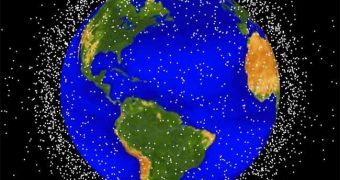A group of analysts believes that there is no possible way of cleaning up Earth's clogged orbit without the establishment of an international fund that would gather the necessary money.
Years and years of reckless launches and orbital maneuvers have left their mark on the lower portions of Earth's orbit (LEO), where dead satellites, spent rocket stage and myriads of other space debris share the same cruise altitudes with working spacecraft.
As the world develops, so to does our need to put more and more satellites into space, as well as the need to service, or prolong the lives, of existing ones. Additionally, space exploration is beaconing us to other planets.
But launching manned spacecraft is becoming an increasingly risky endeavor, which has more and more chances of going awry. The maneuvers the International Space Station needs to make regularly to avoid being hit by impactors are proof of this.
Slowly, authorities with space agencies around the world are beginning to realize that things cannot go on. Various initiatives are currently being developed, that would enable the creation of technologies capable of solving this problem.
But the costs of clearing LEO, or other orbits for that matter, are bound to be prohibitively expensive. However, a newly-released report details which of the potential solutions actually has merit.
The basic conclusion of the research is that space agencies can apply the same methods used to combat more “Earthly” dangers such as hazardous waste, pollution, oil spills, and acid rain.
One thing about the international superfund approach is that it can do its job, researchers say. If the will and the commitment to implement it for space debris actually exists is another matter entirely.
The US Defense Advanced Research Projects Agency (DARPA) requested the new study, which was compiled by the global policy think tank RAND, and entitled “Confronting Space Debris – Strategies and Warnings from Comparable Examples Including Deepwater Horizon.”
One of the methods experts at the think tank used to develop their strategies was inspired from how companies here on Earth acted to clean up the areas that they were polluting beyond acceptable levels.
The team then extrapolated ways in which the approaches could be implemented for space junk removal, and came up with feasible ways of doing so, Space reports.
“We tie orbital debris to things that were more intuitive, things that people sort of run into on a daily basis. We purposely tried to tie the space debris problem to some environmental issues […] to start making some connections in people's heads,” says study coauthor Dave Baiocchi.
“We didn't quite have our act together for Deepwater Horizon. Maybe we don't quite have our act together for the space debris problem either,” he adds.

 14 DAY TRIAL //
14 DAY TRIAL //